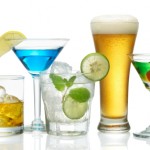Twenty-four years ago I was the brand new Deputy Chief of Staff at our largest Air Force medical center. My counterpart at the Army's hospital across town called and asked if I'd like to attend a party. I said, "Sure, what's the occasion?"
His commander had just gotten a second star and, as a new major general, would be moving to DC soon. His immediate boss was going to get the one-star job running the medical center. That never happened. I don't know the exact details, but was told one drink too many led to an off-color comment to the wrong person and then to a lost opportunity.
I got sensitized, through this episode, to drinking at events and, of course, to drinking and driving. I was in a culture where wine and beer flowed freely at parties, but decided I'd be a one-drink person. My wife and I were outliers sometimes; a friend who was a fellow commander when I moved up to lead a small hospital once told me, "I got picked up CWI last night."
"I know what DWI means; what's CWI?"
He replied, "Crawling while intoxicated." Actually he was joking, while telling his story of leaving a party at the commanding general's home and feeling unsteady while slowly walking to his own quarters, two houses down.
The Wall Street Journal on July 2, 2011, had an article titled "Testing the Limits of Tipsy." Our US legal limit for driving used to be a blood alcohol concentration (BAC) of 0.15%; now it's 0.08%. In much of Europe it's 0.05%; in India it's 0,03% and in China it's 0.02%. That exceedingly low BAC limit may turn out to be the most realistic, especially on crowded streets and roads.
Our alcohol-related traffic fatalities have fallen by 50% since 1980, but still account for one-third of all deaths on the highway. Your BAC after drinking depends on a number of factors: your weight, age, prior drinking history, rate of consumption, if you're also eating (consuming food may slow absorption of alcohol, but some foods help more than others) and menstrual cycle (women apparently metabolize alcohol a little more rapidly just after ovulating).
Once you've absorbed alcohol, your BAC falls roughly 0.015% per hour (for either gender), so it may take a long time to reach a "safe" level, if there is such a thing. As you age your liver tends to metabolize alcohol more slowly; on the other hand, an elevated BAC may affect younger brains more adversely.
Having read this, I'll plan to continue our long-standing policy: when we go to a function one of us is the "designated drinker," and usually has only one drink at that. The other is the designated driver. We've occasionally each had a glass of wine...at an event where we'll be eating and not driving for a number of hours. It may be time to re-evaluate that policy.
On holidays like New Years Eve, when we know others will be drinking more than we do, we get off the roads early.
Tags: drinking and driving, medically-related food issues, motor vehicles accidents


